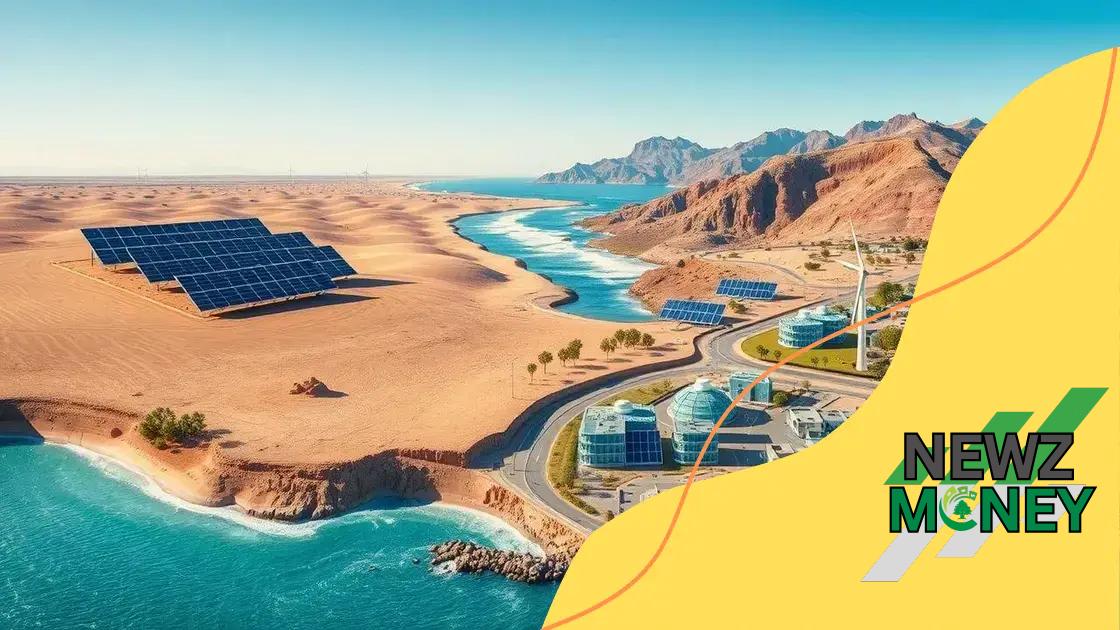Green energy solutions for large-scale projects that work

Green energy solutions significantly reduce pollution, lower costs, and provide economic benefits, though challenges such as initial investments and infrastructure updates must be addressed for a sustainable future.
Green energy solutions for large-scale projects are becoming increasingly vital in our quest for a sustainable future. But how can these innovative approaches truly reshape our energy landscape? Let’s delve into the options available.
Understanding green energy solutions
Understanding green energy solutions is crucial in today’s changing world. These solutions are not just about using clean energy; they involve innovative methods to harness natural resources sustainably.
What Are Green Energy Solutions?
Green energy solutions encompass various technologies and practices aimed at reducing carbon footprints. They rely on renewable sources like solar, wind, hydro, and geothermal energy. By using these resources, we can power our homes and industries while protecting the environment.
Advantages of Green Energy
There are numerous benefits to adopting green energy solutions:
- Reduced greenhouse gas emissions
- Lower long-term energy costs
- Enhanced energy security
Moreover, these solutions often lead to healthier communities since they minimize air and water pollution. Switching to renewable energy not only preserves our planet but also creates jobs in emerging industries.
Many countries are investing heavily in green technologies to meet energy demands while combating climate change. From wind farms to solar parks, we are witnessing a remarkable shift. For instance, areas that previously relied on fossil fuels are now leading the way in renewable energy advancements.
Technology in Action
Innovative technologies are driving the growth of green energy solutions:
- Solar panels have become more efficient and affordable.
- Wind turbines now generate power more reliably than ever before.
- Smart grids help manage energy distribution more effectively.
By understanding these technologies, we can better appreciate how they contribute to a greener planet. The future is bright for renewable energy, offering hope for sustainable living.
As we explore green energy solutions, it’s important to grasp the challenges that still exist. Transitioning from traditional energy sources requires investment, education, and policy support. However, the potential benefits far outweigh these obstacles, paving the way for a resilient future.
Benefits of renewable energy in large projects
The benefits of renewable energy in large projects are transforming the landscape of energy consumption. These advantages extend beyond just environmental concerns; they include economic and social impacts that shape communities.
Reduced Environmental Impact
One of the most significant advantages of renewable energy is its ability to reduce environmental pollution. Unlike fossil fuels, renewable sources produce little to no harmful emissions. This shift helps combat climate change and protects ecosystems.
Cost Efficiency
Adopting renewable energy can lead to substantial cost savings in the long run. While the initial investment may seem high, operational costs are often lower than those of traditional energy sources. This is due to minimal fuel costs and fewer maintenance needs.
- Lower utility bills for consumers
- Stable energy prices
- Job creation in the renewable sector
Moreover, as technology advances, the efficiency of renewable systems improves. This not only enhances power output but also drives prices down, making renewables more accessible.
Introducing renewable energy in large projects can also enhance energy independence. Reduced reliance on imported fuels means greater control over energy sources. This stability is crucial for both national security and local economies.
Social Advantages
Renewable energy projects foster job growth in various industries, creating opportunities in construction, installation, and maintenance. These jobs are often more stable and can lead to a skilled workforce. Communities that embrace renewable projects often see an increase in local investments, further boosting economic development.
Furthermore, renewable energy can improve health outcomes. By decreasing air and water pollution, communities experience better health, leading to lower healthcare costs and improved quality of life. Enhanced public health supports social well-being and can contribute to stronger local economies.
Case studies of successful implementations

Case studies of successful implementations of renewable energy provide valuable insights into the practical application of green technologies. These real-world examples showcase how various projects have harnessed green energy solutions to transform communities and industries.
Solar Power in the Desert
One remarkable case is the solar power plant built in a desert area. By utilizing vast, unused land, the project generated significant energy while minimizing land use conflicts. The plant produced enough electricity to power thousands of homes, demonstrating the efficacy of solar technology.
- Increased energy independence
- Lower greenhouse gas emissions
- Boost to the local economy through job creation
Such projects not only benefit the environment but also stimulate local economies and improve energy access.
Wind Farms Leading the Way
Another successful implementation can be seen in coastal wind farms. These farms leverage strong ocean winds to generate clean energy at scale. By investing in advanced turbine technology, these projects have maximized output and efficiency.
They also highlight the community’s involvement, as many wind farm projects include local stakeholders in the planning process. This inclusion helps ensure that the projects align with community interests and needs.
Furthermore, by providing jobs in construction and maintenance, wind farms contribute to local employment and skills development. Homeowners nearby also benefit from lower energy prices as renewable sources replace traditional fossil fuels.
Geothermal Energy in Urban Areas
Urban areas have also seen the successful implementation of geothermal energy systems. By tapping into the Earth’s heat, cities can provide sustainable energy for heating and cooling. This renewable resource is particularly effective in reducing reliance on fossil fuels and cutting heating costs.
In one city, a geothermal district heating system has provided efficient and low-cost heating to thousands of residents. This initiative showcases how cities can innovate using sustainable resources to meet energy demands.
Each of these case studies demonstrates the diverse applications of renewable energy solutions. They highlight the potential for sustainable practices to reshape the energy landscape while providing economic and environmental advantages.
Key technologies driving green energy
Key technologies driving green energy are at the forefront of transforming how we generate and utilize power. These innovations are shaping a sustainable future by enhancing efficiency and reducing carbon footprints.
Solar Power Technology
Solar panels have significantly evolved in recent years, becoming more efficient and affordable. The use of photovoltaic cells allows sunlight to be converted directly into electricity. Modern solar systems can now easily integrate with smart grids, optimizing energy distribution and consumption.
Wind Energy Turbines
Wind energy has become one of the largest contributors to renewable energy. Advances in turbine design have increased energy output and efficiency. Newer models can harness lower wind speeds, making it feasible to install wind farms in a wider range of locations.
- Vertical-axis turbines for urban areas
- Offshore wind farms leveraging stronger winds
- Smart technology for better energy management
These advancements have greatly expanded the potential for wind energy generation, contributing to a cleaner power supply.
Energy Storage Solutions
Energy storage technologies play a critical role in ensuring that renewable energy can meet demand. Batteries, particularly lithium-ion and emerging solid-state technologies, are becoming essential for storing solar and wind energy when production exceeds consumption.
This capability allows for a more reliable energy supply, smoothing out the peaks and valleys of energy generation. Other methods, like pumped hydro storage, use gravitational energy to save excess energy for later use.
Geothermal Systems
Geothermal energy taps into the Earth’s natural heat for heating and electricity. Enhanced geothermal systems (EGS) improve the ability to utilize heat from deeper within the Earth. This technology is particularly useful in areas where traditional geothermal resources are limited.
Geothermal heat pumps are also becoming popular in residential and commercial buildings, providing an efficient way to heat and cool spaces.
Overall, these key technologies illustrate how green energy is progressing towards a sustainable future. By embracing innovation across various sectors, we can create a cleaner and more efficient energy landscape.
Challenges and future outlook for sustainability
Challenges and the future outlook for sustainability are critical topics in the discourse surrounding green energy solutions. While significant progress has been made, barriers remain that can hinder the transition to sustainable practices.
Barriers to Adoption
One major challenge is the initial cost of renewable energy technologies. Many green energy solutions require substantial investment upfront. This can deter companies and governments from making the switch, even though long-term savings often outweigh these initial costs.
Infrastructure Limitations
The existing energy infrastructure also poses challenges. Integrating renewable sources into current power grids can be complex and requires updates to technology and regulations. For many places, the transition to a modern energy grid is slow and costly.
- Need for improved energy storage systems
- Regulatory hurdles that slow down project approvals
- Misalignment between federal and local policies
Furthermore, the intermittency of sources like solar and wind energy requires innovative solutions for energy storage and management, ensuring reliable energy supply.
Public Awareness and Acceptance
Public perception plays a vital role as well. Misinformation about renewable technologies can lead to skepticism. Educating communities on the benefits and feasibility of green energy is essential in promoting acceptance and encouraging adoption.
Looking towards the future, there is reason for optimism. As technologies advance, costs are expected to decrease, making renewable energy more accessible. Policies that promote sustainable practices will likely become more prevalent as governments commit to fighting climate change.
New innovations in battery storage and smart grid technology can enhance efficiency, allowing for a smoother transition to renewable sources. Additionally, partnerships between public and private sectors can facilitate investments and accelerate advancements.
The future of sustainability relies not only on technology but also on collective action. With increased collaboration, understanding, and persistent efforts, we can overcome current challenges and create a sustainable energy future.
FAQ – Frequently Asked Questions about Renewable Energy Solutions
What are the main benefits of renewable energy?
Renewable energy reduces pollution, lowers energy costs over time, and provides significant economic benefits to communities.
What challenges does renewable energy face today?
Key challenges include high initial costs, outdated infrastructure, and public awareness regarding renewable technologies.
How can communities support the transition to renewable energy?
Communities can support this transition through education, advocating for policies that promote sustainability, and investing in local renewable projects.
What is the future outlook for renewable energy technologies?
The future is promising, with lowering costs, technological advancements, and increasing adoption of renewable sources expected to drive a sustainable energy future.





